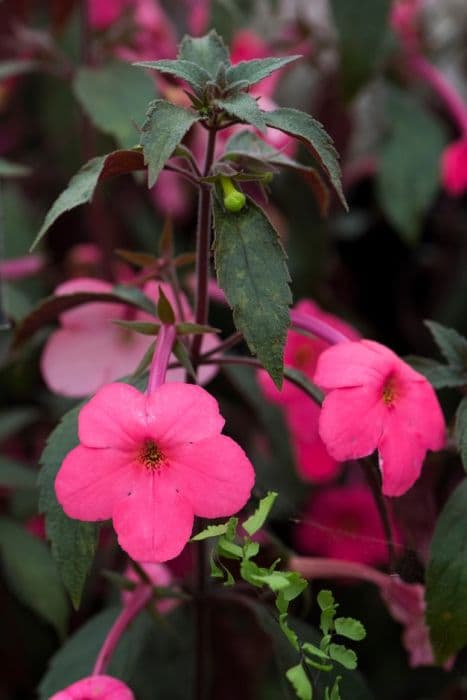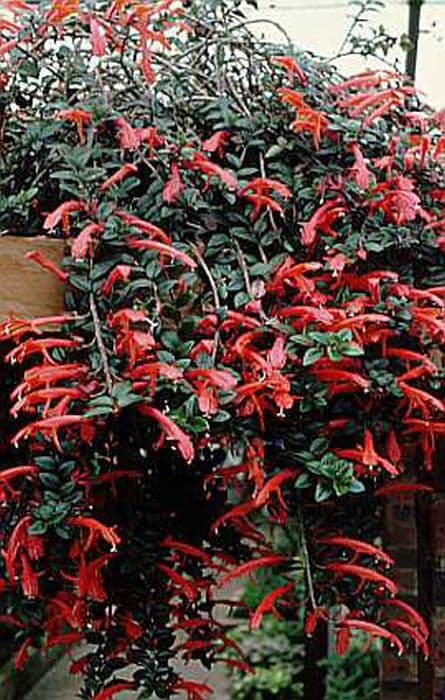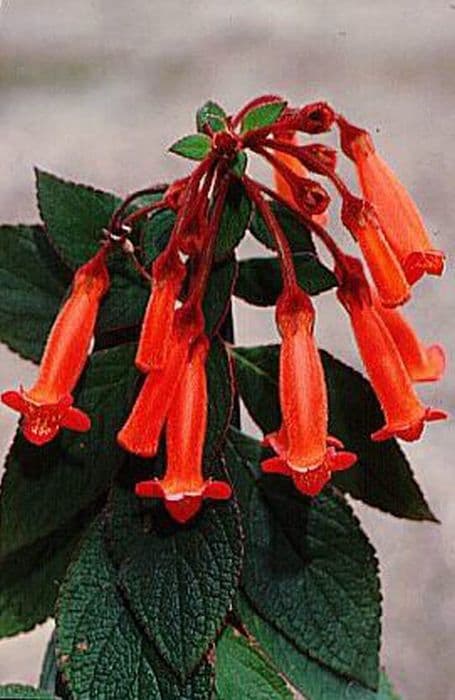Cape primrose 'Harlequin Purple' Streptocarpus 'Harlequin Purple'

ABOUT
'Harlequin Purple' is a compact evergreen perennial to about 20cm producing a rosette of hairy, strap-shaped leaves. Clusters of flowers, 5.5cm across, with purple upper lobes and cream lower lobes streaked with purple, are produced from early spring to late autumn
About this plant
 Names
NamesFamily
Gesneriaceae
Synonyms
Cape Primrose, African Violet
Common names
Streptocarpus 'Harlequin Purple'.
 Characteristics
CharacteristicsLife cycle
Perennials
Foliage type
Evergreen
Color of leaves
Green
Flower color
Purple
Height
1 foot (30 cm)
Spread
1 foot (30 cm)
Plant type
Herb
Hardiness zones
10
Native area
Tanzania
Benefits
 General Benefits
General Benefits- Easy to Care For: The Cape Primrose is generally a low-maintenance plant which doesn't require extensive gardening skills, making it suitable for beginners.
- Long Blooming Period: It often has a lengthy flowering period that can last several months with proper care, providing long-lasting color to interiors.
- Attractive Foliage: The velvety leaves add a lush green backdrop, enhancing the aesthetic of indoor spaces even when the plant is not in bloom.
- Variety of Colors: The 'Harlequin Purple' variety, like its relatives, comes in various colors and patterns which can complement various decor styles.
- Compact Growth: Being a compact plant, it is ideal for small spaces, windowsills, and limited shelf space.
- Ideal for Indoor Gardens: Suitable for growing indoors, the Cape Primrose makes an excellent choice for adding greenery to apartments and homes.
- Hybrid Vigor: As a hybrid plant, it may benefit from increased robustness and resistance to diseases compared to some non-hybrid varieties.
 Medical Properties
Medical PropertiesThis plant is not used for medical purposes.
 Air-purifying Qualities
Air-purifying QualitiesThis plant is not specifically known for air purifying qualities.
 Other Uses
Other Uses- Cape Primrose 'Harlequin Purple' can be used in miniature gardens to create a colorful backdrop or accent due to its vibrant purple blooms.
- As a photographic subject, the distinct patterns and colors of the Cape Primrose 'Harlequin Purple' provide an excellent opportunity for macro photography enthusiasts.
- When pressed and dried, the leaves and flowers of the Cape Primrose 'Harlequin Purple' can be used in crafting, such as in handmade paper or bookmarks.
- Cape Primrose 'Harlequin Purple' is used in educational settings, such as biology classes, to teach about plant reproduction and hybridization due to its interesting breeding.
- The plant can be used as an element in art installations, especially for conveying themes of natural beauty and diversity.
- Cape Primrose 'Harlequin Purple' petals are sometimes used for creating natural dyes for fabrics and art projects, offering a range of purple hues.
- As part of a sensory garden, the texture and shape of the Cape Primrose 'Harlequin Purple' provide a tactile experience for visitors.
- The vibrant flowers of the plant can be used in tabletop displays or fairy gardens, adding a touch of whimsy and color.
- Botanical illustrators may use the Cape Primrose 'Harlequin Purple' as a subject to study plant anatomy and to practice their illustration skills.
- Greeting card designers can use pressed or photographed Cape Primrose 'Harlequin Purple' flowers as embellishments or central themes for botanical greeting cards.
Interesting Facts
 Feng Shui
Feng ShuiThe Cape Primrose is not used in Feng Shui practice.
 Zodiac Sign Compitability
Zodiac Sign CompitabilityThe Cape Primrose is not used in astrology practice.
 Plant Symbolism
Plant Symbolism- Endurance: The Streptocarpus, also known as Cape Primrose, often represents endurance because of its ability to thrive with minimal care and in less-than-ideal conditions.
- Adaptability: Reflecting its capacity to adapt to various environments, Cape Primrose symbolizes flexibility and the ability to prosper in different life situations.
- Long-lasting Love: The long blooming period of the Cape Primrose is often associated with enduring affection and can symbolize a love that withstands the test of time.
- Hope and Rejuvenation: As the Cape Primrose can bloom throughout the year, it is seen as a symbol of hope, continuous growth, and rebirth.
 Water
WaterCape primrose should be watered when the top inch of soil feels dry to the touch, which typically amounts to once a week, though the frequency may increase during hot, dry periods or decrease in cooler, less bright conditions. Use room temperature water and apply it gently around the base of the plant, allowing the water to soak into the soil without wetting the foliage. Aim to provide enough water so that a small amount runs out of the drainage holes, typically using around 8-16 ounces of water for a 6-inch pot, and adjust based on the size of your plant and pot. Avoid letting the plant sit in standing water as this can lead to root rot.
 Light
LightCape primrose thrives in bright, indirect light but should be shielded from direct sun, which can scorch its leaves. A north-facing windowsill or an east/west-facing window with some light shading are ideal spots for this plant. If using artificial lights, aim for fluorescent or grow lights that can provide a similar intensity without the heat of direct sun.
 Temperature
TemperatureCape primrose prefers consistent temperatures between 60°F and 75°F, which makes it ideal as a houseplant in most climates. It should be kept away from cold drafts and heating vents, and can tolerate a brief period outside this range but should not be exposed to temperatures below 50°F or above 80°F as this could damage the plant.
 Pruning
PruningPruning Cape primrose helps to encourage bushier growth and remove any spent or yellowing leaves. It's best to prune right after the main blooming period has finished. Pinch or cut back leggy stems, remove dead flower stalks at their base, and get rid of any damaged foliage. Perform light pruning every few months to keep the plant looking tidy.
 Cleaning
CleaningAs needed
 Soil
SoilThe Cape Primrose requires a porous, well-draining soil mix, ideally a combination of potting soil, perlite, and peat moss. The pH should be slightly acidic to neutral, around 6.0 to 7.0 for optimal growth.
 Repotting
RepottingCape Primrose should be repotted once every year or two, or when it outgrows its pot, to refresh the soil and provide room for root growth.
 Humidity & Misting
Humidity & MistingCape Primrose thrives in moderate to high humidity levels, preferably between 50-60%, to mimic its native tropical environment.
 Suitable locations
Suitable locationsIndoor
Place Cape Primrose in bright, indirect light, away from drafts.
Outdoor
Grow in shaded area with protection from strong sun and winds.
Hardiness zone
10-11 USDA
 Life cycle
Life cycleThe life of Streptocarpus 'Harlequin Purple', commonly known as Cape Primrose, begins with germination, where seeds sprout in warm, moist conditions typically within three weeks. Seedlings emerge and grow into vegetative plants with characteristic rosettes of long, soft leaves. The vegetative stage is lengthy as the plant matures and produces more foliage, during which it can be propagated by leaf cuttings. Following the vegetative stage, the plant enters the flowering phase, producing vivid purple flowers with distinct markings during the spring and summer. After pollination, which can occur via insects or self-fertilization, the plant sets seed, encased in twisted, pod-like capsules. The life cycle can conclude after setting seed or continue, as Cape Primrose can live for several years and may enter a period of dormancy during the cooler months, only to resume growth with the onset of the next growing season.
 Propogation
PropogationPropogation time
Spring to Summer
The most popular method for propagating Streptocarpus 'Harlequin Purple', also known as Cape Primrose, is through leaf cuttings. This can be done at any time of the year, but the best results are typically seen when done in spring or early summer. To propagate by leaf cuttings, a healthy leaf is selected and cut across the width of the leaf into sections that are about 1.5 to 2 inches (approximately 4 to 5 cm) long. Each section is then inserted into a moistened potting mix, with about a third to a half of the cutting buried in the soil. The potting mix should be kept consistently moist but not waterlogged, and the cuttings should be placed in a warm, brightly lit area without direct sunlight. Roots usually develop within a few weeks, after which the new plants can be potted up individually. This method is favored for its simplicity and effectiveness in producing new plants that are true to the parent's characteristics.









